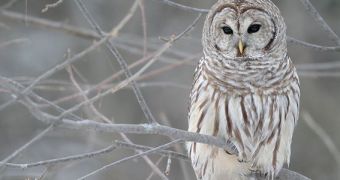According to a new model developed by scientists with the US Geological Survey (USGS) and the US Forest Service (USFS), aggressive barred owl populations in the Pacific Northwest and northern California are driving native Northern spotted owls – a native species – into decline.
Due to pressure from the larger barred owls and ever-decreasing habitats, spotted owl populations are nowadays declining at a very fast rate. They lack the higher reproductive capacity of their competitors, as well as the ability to adapt to a more varied diet.
Another issue they are facing is their inability to adapt their use of their habitats according to how the latter are changing. This is not a new process, since Northern spotted owls have been designated as threatened years ago. The conclusions reported in the new study are based on 22 years of data.
The investigation covered a site totaling 1,000 square kilometers (386 square miles) in Oregon. What the team found was that both species tended to vacate a given habitat whenever the other entered it. Since barred owls are more aggressive, the balance appears to tip in their favor.
“While both species feel the effects of competition, spotted owls are far more sensitive. As a result, spotted owls at this site, and in many other areas, are declining while barred owl numbers steadily increase,” explains USGS research statistician Charles Yackulic.
The expert was also the lead author of the new study, entitled “The roles of competition and habit in the dynamics of populations and species distributions.” The paper appears in the latest issue of the scientific journal Ecology, and it is also available online.
The newly-developed model appears to suggest that, over the next few decades, barred owls will continue their aggressive push to incorporate new habitats into their range, driving spotted owl populations to lower and lower numbers.
“Scientists in other parts of the Pacific northwest have suggested that differences in the habitat preferences of the barred owl and spotted owl might allow them to coexist,” Yackulic explains.
“While the two species showed different habitat preferences in this study site, there is still substantial overlap in habitat use. As a result, in recent years, barred owls have frequently excluded spotted owls from habitat that they would otherwise prefer.” he adds.
While it is true that spotted owls may occupy other habitats, the fact remains that not many suitable habitats are still available, due to encroaching human interference. A decreased habitat quality translates into fewer chances of successfully producing offspring, which further contributes to population decline.

 14 DAY TRIAL //
14 DAY TRIAL //